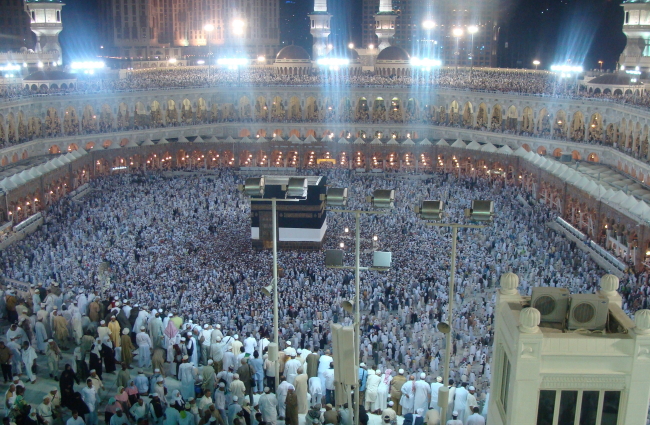
OVERWHELMING NUMBERS of people make the annual Hajj a real-life experience of the global diversity of Islam. Photo of an earlier Hajj by Hassan Morowa, courtesy of Pexels
.
TUESDAY, JULY 28: Millions of Muslims who planned to make the pilgrimage to Mecca this year will be staying home as Saudi Arabia, the keeper of the holy places, has announced a COVID-limited Hajj this year that could involve only about a thousand pilgrims who live in the region. In addition, no one over age 65 will be allowed to participate to avoid infecting the most vulnerable men and women. (Al-Jazeera has more details.)
Among the pillars of Islam, the world’s nearly 2 billion Muslims are expected to visit Mecca and fulfill the Hajj rituals that reenact the actions of the Prophet Muhammad in his “farewell pilgrimage,” in 632 AD. Arriving via every mode of transportation available and from countries that circle the globe, this annual Islamic pilgrimage is widely considered the largest annual gathering in the world.

Click this cover to jump back to early 2019 for our story about the launch of “Our Muslim Neighbors,” explaining the importance of meeting the Muslim families who are such important parts of our communities.
In the U.S.—Pew Research estimates there are 3.45 million Muslims, making up 1.1 percent of the American population.
However, most Americans have never actually met our millions of Muslim neighbors.
To help celebrate the Hajj this year—it’s time to change that. It’s time to reach out and talk with our Muslim co-workers and neighbors. If we do reach out, we usually discover new friends with similar values—and the entire community is enriched by our new friendships.
That is why we are urging all of our readers to turn back to this January 2019 cover story in which we suggest a way to take that next step—through the pages of Victor Begg’s new memoir.
You will meet Victor, his wife Shahina and their entire family in this engaging book, titled Our Muslim Neighbors—Achieving the American Dream, an Immigrant’s Memoir. The book includes Victor’s description of his own Hajj experiences, which is a great way for non-Muslims to learn about this centuries-old tradition that is limited to Muslims.
Readers also will recognize their own core American values as they enjoy reading about Victor’s courageous attempts to live out those values, sometimes in the midst of tragedy.
“This is a true blue American story—my story of how I came to this country and built a successful business and a life for my family that contributed to our community in so many ways,” Victor says. “Along the way, I realized that most Americans don’t know any Muslims and that heightened bigotry arises because people don’t know that our families are just like their families. We share so many community and spiritual values—and we would discover that if we simply reached out—if we simply got to know each other.”
That’s also what Bill Tammeus, one of the most respected religion writers in the U.S., concluded after reading Victor’s book. Here’s a sample of what Bill wrote:
This is a highly personal story, but Begg’s experience and thinking can encourage all Americans to get to know their Muslim neighbors—to say nothing of neighbors of all other (and no) religious traditions. When people are religiously illiterate, it can lead to fear, which can lead to hate, which can lead to violence. We’ve been there before. This book is a helpful road map in a better direction.
..
THE ORIGINS OF HAJJ: ABRAHAM, HAGAR & ISHMAEL
Islamic tradition tells that in approximately 2000 BCE, Abraham was ordered by God to leave his wife, Hagar, and his son, Ishmael, in the desert of Mecca while he traveled to Canaan. After Abraham left, food and water quickly ran out; Hagar ran back and forth between the hills of Safa and Marwa seven times. Exhausted, Hagar laid Ishmael on the sand and begged God for help. Miraculously, a well sprang up at the baby’s feet, and that well—the Zamzam Well—continues to provide ample water to Hajj pilgrims today. Later, according to Muslim tradition, Abraham was commanded to build the Kaaba, so that people could perform pilgrimage there. It is believed that the Archangel Gabriel brought the Black Stone from heaven to be attached to the Kaaba, and today, the Black Stone marks the beginning and ending point of each circle a pilgrim makes as he circulates the Kaaba during Hajj.
Jahiliyyah: During a time known as jahiliyyah in pre-Islamic Arabia, the Kaaba had become surrounded by pagan idols. To cleanse the Kaaba, the Prophet Muhammad led his followers from Medina to Mecca in what is now regarded as the first Hajj. The pagan idols were destroyed, and Muhammad rededicated the Kaaba to God. At this point, Hajj became one of the five pillars of Islam, and adherents have been making the journey ever since.

Tell Us What You Think